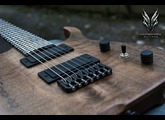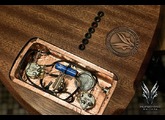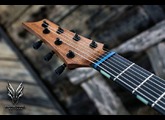« Hufschmid 2.0 : impressive update! »
Published on 02/18/15 at 08:23
Best value:
Excellent
Audience:
Advanced Users
I met Patrick Hufschmid in march 2010.
At that time I was looking for my first seven string, and I wasn’t convinced by the factory models. Thus I came across Patrick’s work in a random forum, and a few weeks later I received the first of the four Hufschmid I own today : the H7, then a Mockingbird-based H6, a standard H6 and finally the H7 Baritone we are talking about here.
Why a second seven string?
In five years, many things can evolve, and first of all, the musician’s playing. Of course I still felt comfortable on my first H7, but I was attacking the strings stronger and stronger everyday, so I felt a longer neck scale would offer a better and faster response. I also needed a tone knob, which my H7 didn’t have (as I didn’t want one then).
The musician progresses, and the builder does as well : fighting against stagnation spirit which wastes many builders who keep resting on their laurels offering the same old but slightly varied song each year, Patrick is constantly searching improvement in every little detail on his instruments.
Thus some new stuff appeared since my first H7 :
-New head with straight pull design using no string guide
-Techtron HPV® nut, a self-lubricant and extremely tough thermoplastic material
-Hufglow blocks on the fingerboard, very efficient in the dark
-New high quality epoxy pickup rings
-Custom electronic components, etc.
For the other specs :
-Scale length : 26.2“
-One piece Premium FSC certified quatersawn Sapelli Mahogany body
-One piece Premium FSC certified rift-sawn Sapelli Mahogany neck
-Premium FSC certified West African Ebony fingerboard
-Salvaged Bastogne Walnut (the world’s rarest Walnut specie) top
-Fingerboard radius : 12“
-Kent Armstrong custom handmade pickups
-Hipshot hardtail bridge
-Hipshot locking tuners
-Natural finish
-Tuning : Drop A (A E A D G B E), 10-52 + 68 string gauges
The craftmanship is exquisite, I had friends testing the guitar and they didn’t think first it was a handmade instrument.
The neck, which is the most important thing in my opinion, is perfectly set and stable, very sturdy. Its profile, rounder on the first frets and flatter on the last ones, makes it ridiculously easy to play, despite of the longer scale. The guitar is light (3.2kg / 7lbs) and very well balanced, and its tuning stability is exemplary.
When coming to sound, all I was expecting is here : clean sounds are gorgeous, defined, clear and warm at the same time, the tone knob makes wonders here.
You can feel this clear character even stronger when switching to a crunch sound, each note can be heared without ever getting aggressive so you can play either hard or mellow by sligthly changing your attack. With a hi-gain sound, the instrument and pickups precision are a must for modern metal. Even the lowest notes are striking, powerful and still thick in rhythm playing, and the leads are sweet in neck position, cutting in bridge position.
I play this guitar either on a Fender Tweed Deluxe, a Hughes & Kettner Tubemeilster or an Axe-FX II, and the resulting sound is always way above my other instruments. Jazz, funk, blues, rock, hard… Everything is possible because, far from bounding to metal and djent, a seventh string extends the guitars range, turning it into something more versatile, especially on a high-end instrument.
I do not use this H7 for long, but its formidable physical and technical precision as well as its impressive range of different tones already convinced me : it is one of those unique instruments who give you thrill each time you grab it, knowing it is going to be a partner for life, getting better with time.
One of those magical instruments only my friend Patrick Hufschmid holds the secret of.
At that time I was looking for my first seven string, and I wasn’t convinced by the factory models. Thus I came across Patrick’s work in a random forum, and a few weeks later I received the first of the four Hufschmid I own today : the H7, then a Mockingbird-based H6, a standard H6 and finally the H7 Baritone we are talking about here.
Why a second seven string?
In five years, many things can evolve, and first of all, the musician’s playing. Of course I still felt comfortable on my first H7, but I was attacking the strings stronger and stronger everyday, so I felt a longer neck scale would offer a better and faster response. I also needed a tone knob, which my H7 didn’t have (as I didn’t want one then).
The musician progresses, and the builder does as well : fighting against stagnation spirit which wastes many builders who keep resting on their laurels offering the same old but slightly varied song each year, Patrick is constantly searching improvement in every little detail on his instruments.
Thus some new stuff appeared since my first H7 :
-New head with straight pull design using no string guide
-Techtron HPV® nut, a self-lubricant and extremely tough thermoplastic material
-Hufglow blocks on the fingerboard, very efficient in the dark
-New high quality epoxy pickup rings
-Custom electronic components, etc.
For the other specs :
-Scale length : 26.2“
-One piece Premium FSC certified quatersawn Sapelli Mahogany body
-One piece Premium FSC certified rift-sawn Sapelli Mahogany neck
-Premium FSC certified West African Ebony fingerboard
-Salvaged Bastogne Walnut (the world’s rarest Walnut specie) top
-Fingerboard radius : 12“
-Kent Armstrong custom handmade pickups
-Hipshot hardtail bridge
-Hipshot locking tuners
-Natural finish
-Tuning : Drop A (A E A D G B E), 10-52 + 68 string gauges
The craftmanship is exquisite, I had friends testing the guitar and they didn’t think first it was a handmade instrument.
The neck, which is the most important thing in my opinion, is perfectly set and stable, very sturdy. Its profile, rounder on the first frets and flatter on the last ones, makes it ridiculously easy to play, despite of the longer scale. The guitar is light (3.2kg / 7lbs) and very well balanced, and its tuning stability is exemplary.
When coming to sound, all I was expecting is here : clean sounds are gorgeous, defined, clear and warm at the same time, the tone knob makes wonders here.
You can feel this clear character even stronger when switching to a crunch sound, each note can be heared without ever getting aggressive so you can play either hard or mellow by sligthly changing your attack. With a hi-gain sound, the instrument and pickups precision are a must for modern metal. Even the lowest notes are striking, powerful and still thick in rhythm playing, and the leads are sweet in neck position, cutting in bridge position.
I play this guitar either on a Fender Tweed Deluxe, a Hughes & Kettner Tubemeilster or an Axe-FX II, and the resulting sound is always way above my other instruments. Jazz, funk, blues, rock, hard… Everything is possible because, far from bounding to metal and djent, a seventh string extends the guitars range, turning it into something more versatile, especially on a high-end instrument.
I do not use this H7 for long, but its formidable physical and technical precision as well as its impressive range of different tones already convinced me : it is one of those unique instruments who give you thrill each time you grab it, knowing it is going to be a partner for life, getting better with time.
One of those magical instruments only my friend Patrick Hufschmid holds the secret of.



